On June 22, 2015, BPMilwaukee launched, adding to the Internet a concise and rapidfire analytical spin on our beloved Milwaukee Nine. I know this because I began my acquaintance with BPMilwaukee as an everyday fan, and BPMilwaukee quickly became a necessary read. There was instantly a sort of crisp, consistent presentation that let each point shine on its own. The team of writers often diverged, offering a range of arguments and supporting data to allow the reader to settle the score on their own, they tackled labor and revenue issues, they looked deep into historical data, and they were (and still are) often tougher on the Brewers than many other websites.
June 22, 2015
Introduction to BPMilwaukee
Brewers Farm Update (Featured Prospect: Marcos Diplan)
Kyle Lohse and the Limit of DIPS
Adam Lind: A Moveable Piece
The Continuing Costs of Miller Park
Of course, BPMilwaukee launched at arguably the most opportune moment for a sports website, outside of a thrilling contending run. Having just completed a brutal collapse in 2014, the 2015 club flatlined and looked more like a deflated old club than a bunch of veterans rounding up for “one last go” at an NL Central title. So, BPMilwaukee cut its teeth on rebuilding ideas, thriving in the perfect environment for analysis, big arguments, and “big picture” posts. It is in this vein that we push onward in 2016, pushing tension in favor of and against the ideas of rebuilding, digging into player expectations and disappointing performances alike.
To celebrate BPMilwaukee’s first anniversary, several writers and the founding Editor-In-Chief look at the state of the Brewers.
A Dream Come True In The Big Leagues (J.P.Breen)
The Milwaukee Brewers entered the 2016 campaign with no expectations — hell, that’s not accurate, more like brutally negative expectations — and the club, indeed, has delivered a 32-40 record with a run differential of -58. Baseball Prospectus only has them on pace for 73-74 wins. With that in mind, it may be strange to assert that the Brewers’ big-league season has largely been a dream come true.
Context matters, though. The major-league club had two major goals this season: (1) to identify young players who could help in the future, and (2) to increase the trade value of veteran players who don’t profile as core pieces in the ever-elusive “next competitive team” in Milwaukee.
So much attention is being paid to the Brewers’ burgeoning farm system — perhaps rightfully so — but the club desperately needed a couple of young players to step up and claim spots on the 25-man roster for the foreseeable future. Jonathan Villar has been one of the best shortstops in the National League, hitting .292/.377/.423 with six homers and 25 stolen bases. His .389 BABIP remains unsustainable, but he’s shown improved selectivity at the plate and should be able to be productive enough to slide over to third base once Orlando Arcia arrives. Similarly, Zach Davies has displayed an ability to throw four pitches for strikes and is in the midst of a nine-start streak in which he owns a 2.40 ERA. The right-hander isn’t a top-of-the-rotation arm; however, he’s making a strong claim to be a long-term starter as a back-end guy, who can occasionally put together sterling stretches when his command is pristine. One shouldn’t discount the job Jeremy Jeffress has done in the ninth inning, either.
The Brewers also made a few offseason moves to bring in veteran players. Sure, the club hoped to plug some roster holes and to field a better ballclub, but players such as Chris Carter, Aaron Hill, and Chase Anderson were acquired as upside trade chips. It’s largely worked out, too, as Carter is fourth in the National League with 18 homers and has proven competent defensively at first base. Considering he has a couple of arbitration years remaining, he’s a decent little trade chip for a contender. In addition, Aaron Hill is hitting .311/.407/.473 with six homers and a 25-to-22 strikeout-to-walk ratio since the beginning of May. Many contending teams will need a veteran bat to fill a hole in the infield or on the bench, which means the 34-year-old LSU alum will likely be donning a different uniform in July.
Both Carter and Hill aren’t main trade chips — those are Lucroy and Braun — but they were acquired for very little money and could each bring back a decent low-minors prospect or two at the trade deadline. And that’s how rebuilding should be done. Invest short-term money on bounce-back candidates and flip them for minor-league assets. This doesn’t even address the performance of Jonathan Lucroy, who has massively inflated his trade value by hitting .305/.363/.510 with 14 doubles, three triples, and 10 homers. His .305 TAv is the second-best of any big-league catcher this season (min. 200 PA). The 30-year old backstop will be one of the best players on the market this spring, and the Brewers could acquire multiple prime pieces in return.
So, yes, the win-loss record may not be ideal, but the 2016 campaign has been an utter success for the Brewers. They’ve identified a couple of long-term assets who are young and controllable. They’ve benefited from a couple of short-term acquisitions who have improved their trade value and could bring back something useful to the organization. They’ve also seen their best trade chips perform exceedingly well. For a rebuilding club, I’m not sure for what else anyone could have hoped. It’s been a great season for the organization, as it seems their rebuild may not take as long as many had previously feared.
The Braun Resurgence (Jack Moore)
In the past calendar year, covering 133 games, Ryan Braun is hitting .319/.385/.526. He has not quite reached his lofty career years of 2011 and 2012, when he hit a robust .326/.394/.596 with 74 combined home runs, but Braun is back at an All-Star level and has managed to re-establish himself as one of the 20 or so best hitters in the major leagues.
It has been invigorating to watch Ryan Braun reinvent himself as a hitter over the past year and change. Formerly a dead pull hitter, Braun is now arguably the league’s best hitter at using the opposite field. In 2016, 21 of his 74 hits have gone to the opposite field, including five doubles and three home runs. His 1.069 OPS ranks 32nd out of 172 qualified hitters in 2016; his 1.317 OPS on 122 batted balls to the opposite field in 2015 trailed only Bryce Harper.
Personally, I’m not excited about Braun’s resurgence because it means his trade value is back up again, although I do find it interesting that the formerly untouchable steroid pariah is now a desired commodity. No, I’m excited about it because I love watching Ryan Braun hit. He is the most talented hitter to come through Milwaukee in my lifetime, and if he does stay in Milwaukee through the end of his current contract, his numbers are going to compare very favorably to Hall of Famers Paul Molitor and Robin Yount.
It’s cliche to say that hitting a baseball is the hardest thing to do in sports, but if it isn’t true, it’s damn close. When he’s on, there are few who make it look easier than Ryan Braun does. He’s one of the most gifted talents Milwaukee baseball fans have ever had the privilege to call their own, and that’s why his resurgence has given me so much joy.
The Rotational Development (Ryan Romano)
Let’s begin with an exercise. Recall, from a year and a half ago, your thoughts on the Brewers rotation. Which pitcher stood out to you? Yovani Gallardo didn’t have the stuff he used to, but maybe he’d regain his early-career form. After Mike Fiers made a comeback from his 2013 meltdown, you may have believed he’d become an elite starter. You might have your hopes high on Wily Peralta, who had seemingly broken through in 2014. Perhaps you liked the upside of Jimmy Nelson, feeling he could take a similar step forward. Or maybe the experience and stability provided by Matt Garza and Kyle Lohse suited you best.
Regardless of which aforementioned starter you liked at that time, the last 18 months have probably killed your affinity. Gallardo went to Texas, fluked his way into decent results, then signed a two-year contract with Baltimore that already looks like an awful deal. While Fiers pitched well enough, he was no ace, and since heading to Houston at the trade deadline, he’s completely fallen apart. Peralta lost some of his velocity, stopped throwing strikes, got hurt, and became one of the worst pitchers in baseball. Nelson showed some potential in 2015, but he’s regressed badly in 2016. Garza has made only two starts this year because of a lat strain, after stinking up Miller Park last year. And Lohse has spent this season with the Rangers’ Triple-A affiliate, where he’s floundered just as much as he did at the major-league level.
Now let’s proceed to part two of the exercise. Pretend you knew, back in December of 2014, that all of this would happen. How would you respond? Would you pick up your torch and pitchfork and storm Doug Melvin’s office? Would you renounce your Brewers fandom and start following the Cubs? Or would you remain calm, knowing that a no-name prospect and a journeyman would cushion the fall?
Obviously, no one at that time knew that Zach Davies and Junior Guerra would appear out of nowhere. Most people didn’t even know who the hurlers were — the former played in the Orioles system, and the latter had last pitched professionally in 2012, in the Mexican Baseball League. But both of them rose meteorically in 2015. Davies excelled with Baltimore’s Triple-A club, then the team dealt him to Milwaukee in exchange for Gerardo Parra. Guerra tore through the minors for the White Sox, earning a three-game cup of coffee in the middle of the campaign; the Brewers claimed him off waivers that offseason.
In 2016, the duo has maintained its success. Davies has a 101 DRA- across his 69.7 innings, and Guerra has worked his way to a 3.50 DRA over 61.3 frames. While neither of them began the year with the big-league club, they each earned a shot and took advantage of it. Two respectable starters does not a rotation make, and it would be nice if Peralta, Nelson, and Garza can get their collective shit together. Still, given everything that broke in 2015 and stayed broken in 2016, I’ll gladly take a young groundballer and a crafty veteran.
Craig Counsell’s Role (Kyle Lesniewski)
The first step for the Milwaukee Brewers in beginning their rebuilding process was the dismissal of Ron Roenicke that came 25 games into the 2015 season, with Doug Melvin and Mark Attanasio tabbing Whitefish Bay native and former Brewer Craig Counsell as his successor. Following the end of his playing career in 2011, Counsell joined the Brewers front office to serve as a special assistant to Melvin, and some suggested that the Notre Dame graduate may eventually take over in the General Manager role. Counsell couldn’t ignore his desire to be back in a uniform, however, and his intimate knowledge of the club’s minor league pipeline made him an ideal candidate to lead a team built around young, controllable talent. When Doug Melvin stepped down after the 2015 season, Mark Attanasio made it known to his potential replacements that keeping Counsell on as manager was imperative. Thus far, all indications are that Counsell and new Brewers’ GM “Slingin’” David Stearns work well together and are cut from the same analytical cloth.
At 44, Counsell isn’t much older than some of his players and was even a teammate of veterans like Ryan Braun and Jonathan Lucroy. He hasn’t let his youth stop him from being a well-respected presence amongst the players in the clubhouse and around the league, however. Craig is considered an excellent “baseball mind” and has acquitted himself about as well as can be expected on the field. He has led Milwaukee to a 92-115 record in his parts of two seasons, including a 31-39 record this season with a team that many prognosticators expected to lose 100 games. He’s shown himself to be rather analytically inclined, including the Brewers’ heavy usage of infield shifting this year, as well as his willingness to play around with different lineup combinations, including batting the pitcher eighth. He even got all our hopes up for a matchup-based back end of the bullpen early on in spring, though once Will Smith got injured that sort of fell to the wayside as Jeremy Jeffress has thrived in the role of closer.
Counsell initially signed a three-year contract to serve as the Brewers’ manager back in 2015. It will be interesting to see if Stearns chooses to retain Counsell following the end of his current deal, or if he’ll want to bring in his own “guy.” As Craig is often heard saying during commercial breaks during games, he was “born a Brewer” and personally, I hope that he’s retained long enough to lead the Brewers through this rebuild and toward their next push for the postseason.
A Shift in Philosophy (Seth Victor)
Just a couple months after the launch of this site, the Brewers announced the hiring of a new general manager. David Stearns had spent the previous few years working for Houston–the masters of the tear-down and building through the farm system–so the mere fact that the Brewers hired Stearns signified a shift in general philosophy. Stearns himself has proven adept at his job, but his general profile as an Ivy League graduate with no history of playing professional baseball made him stand out from Doug Melvin, who played in the minor leagues before transitioning to front offices.
Stearns brought with him a new method of building a team, and it is already paying dividends. The Brewers placed tenth on BP’s pre-season farm system rankings, which represented a huge leap. Under Melvin, they were previously 26th (2015), 29th (2014), 27th (2013), and 28th (2012).
The fact that they were able to build such farm depth in essentially just one offseason is quite impressive, and it is emblematic of the shift in priorities. The recent past’s iterations of the Brewers’ farm systems were full of high-upside, low-floor players with a bunch of tools but no guarantees. When players like this work out, you get superstars. But more often than not, they don’t, and then you end up being ranked in the bottom five systems in baseball every year.
But this past year changed that very quickly. The end of the club’s Top Ten includes the list of “Top 10 Talents 25 and Under,” and three of those players–Brett Phillips, Domingo Santana, Jonathan Villar–were acquired in the past calendar year (although Phillips and Santana were products of the Melvin administration). Additionally, the Jean Segura and Khris Davis trades happened after that list was published, and while Isan Diaz and Jacob Nottingham may not appear on this coming year’s version of the list, they have been impressive in the low minors.
The big league acquisitions mirror this approach as well. Stearns spent the offseason making low-risk, low-cost signings like Kirk Nieuwenhuis, Chris Carter, and Will Middlebrooks. Not all of these decisions have worked out, but they didn’t cost the Brewers much and they have given manager Craig Counsell some options.
Stearns’s front office has emphasized building depth throughout the organization, and this will serve the club well. Whether it be at the big league level or in the minors, this past year has been an exercise in creating options at each position, and the Brewers’ surprise record and farm system rankings are evidence of the positive effects this can have on a club.
Doug Melvin and Rebuilding (Nicholas Zettel)
When the history is written, a common standpoint for the Brewers rebuild will be the new administration of GM David Stearns and his organizational overhaul. Stearns represents a crisp break from the previous administration, given the manner in which President & GM Doug Melvin stepped aside; as Seth notes, Stearns also exhibits markedly different roster accumulation strategies thus far. In another regard, Stearns is a great representative of some kind of “new analytics” movement, although in this case Stearns is more similar to Melvin than different, as Melvin was precisely the same kind of “new analytics” guy when he was around 30 years old.
Those facts are pesky, and if the historians ignore those facts, they will miss Melvin’s great contribution to the rebuild.
| Brewers BP Top Prospects | 2014 | 2015 | 2016 (2015 Rank) |
|---|---|---|---|
| 1 | OF Tyrone Taylor | SS Orlando Arcia | SS Orlando Arcia (1) |
| 2 | RHP Jimmy Nelson | OF Tyrone Taylor | OF Brett Phillips (Astros 4) |
| 3 | CF Mitch Haniger | RHP Devin Williams | RHP Jorge Lopez (7) |
| 4 | SS Orlando Arcia | RHP Taylor Williams | OF Trent Clark (not in system) |
| 5 | RHP Johnny Hellweg | OF Monte Harrison | SS Gilbert Lara (6) |
| 6 | OF Victor Roache | 3B Gilbert Lara | RHP Devin Williams (3) |
| 7 | RHP Devin Williams | RHP Jorge Lopez | OF Monte Harrison (7) |
| 8 | RHP Taylor Jungmann | RHP Tyler Wagner | RHP Zach Davies (Orioles 6) |
| 9 | RHP David Goforth | LHP Kodi Medeiros | RHP Cody Ponce (not in system) |
| 10 | SS Yadiel Rivera | RHP Miguel Diaz | OF Tyrone Taylor (2) |
The Brewers’ 2016 Top Prospects list reflects Melvin’s contribution to the future of the organization. The depth that pushed around several of the previous top prospects in the system belonged to Melvin’s administration. First, his 2014 International pick (Lara), along with 2014 and 2015 draft highlights (Clark, Harrison, Ponce), served prominently in the most recent top 10.
Outside of trades and acquisitions, Orlando Arcia and Jorge Lopez headlined a surge of organizational prospects that rushed closer to reaching their potential MLB ceiling, rather than their MLB floor. Arcia and Lopez have long been Melvin farmhands, but now they represent a potential “first division shortstop” and “above average SP,” according to BaseballProspectus scouts. Finally, as others have noted on this very site, Melvin made the first severe slice into rebuilding, and his major returns redefined both the top of the system and its depth.
David Stearns had his work cut out for him when he began his tenure with Milwaukee, and he has answered the call with successful moves that align moreso with acquiring second-chance players than high-ceiling prospects. One can argue that Stearns was able to accomplish this precisely because of Melvin’s wicked trading streak and successful organizational signings. Even without any rebuilding moves, Arcia, Lopez, Trent Clark, Gilbert Lara, Monte Harrison and Cody Ponce (among others) put a positive spin on the Brewers’ farm. If there’s a lesson here for the historians, it’s to apply that “Rebuilding” label with care and precision; Melvin’s greatest contribution to the rebuild assures its swift, relatively brief outlook.
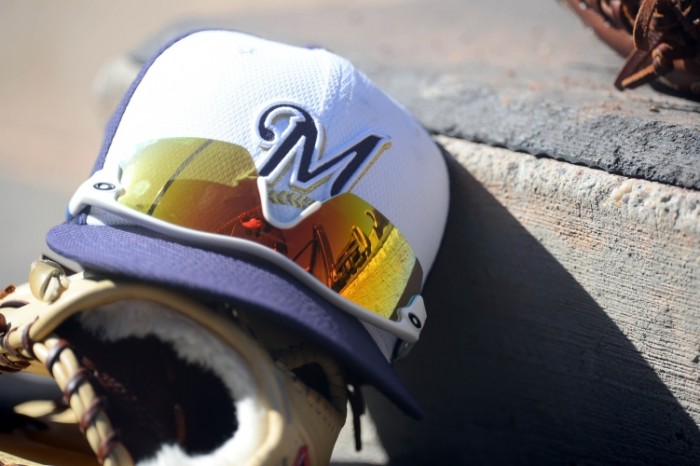

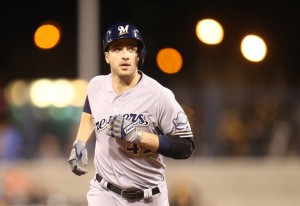
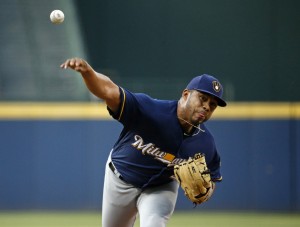
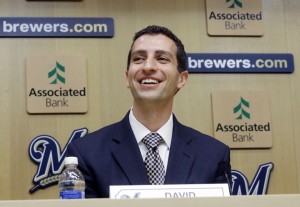
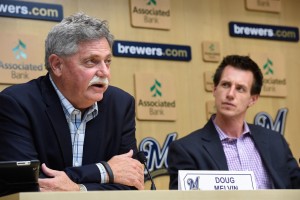
Thanks for your perspectives. All fun reads. Adding Arcia, Phillips, C Ray, Nottingham and Hader to Braun, Lucroy, Villar and Gennett would give us a lineup that would win 90+ games next year- and many years more.